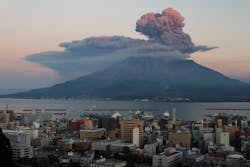A new wireless sensor network being installed in Japan could help scientists more accurately predict the behavior of the country’s most active volcanoes. The system will gather enormous amounts of data used to forecast volcanic activity, identifying when it might be necessary to issue warnings or evacuations.
The sensor network, which will be installed around 47 volcanoes that the Japanese government has selected for around-the-clock observation, will measure several different variables. In addition to the seismic activity that almost always occurs before an eruption, the sensors will monitor gas emissions, topography changes, and vibrations in the air caused by rocks and ash spewing from the volcano.
Japan sits on the western edge of the so-called “ring of fire,” an area around the Pacific Ocean where most of the earth’s volcanic eruptions and earthquakes occur. Sakurajima in southern Japan—which sits only miles from the roughly 600,000 people living in Kagoshima—has been erupting almost continuously for more than 50 years. Other volcanoes in the country are susceptible to “phreatic eruptions,” explosions of super-heated ground water that are notoriously difficult to detect.
In recent years, Japan has placed growing urgency on volcano monitoring. In late 2013, the eruption of Mount Ontakesan in central Japan killed 63 people and prompted the Japan Meteorological Agency, the state weather organization, to review into its volcano forecasting methods. Ultimately, it proposed adding new technology to the agency’s early warning system. The agency has not confirmed that it commissioned the new sensor network.
Because large populations often live in the shadow of Japan’s volcanoes, the sensor network was designed to provide a constant stream of real-time data. The system was built around LoRa technology, a wireless standard for sending data over long distances while consuming little power from end node batteries. The sensors are based on a LoRa transceiver from Semtech Corp., which it says can provide each sensor with at least five years of battery life. In addition, LoRa is capable of adapting data rates to ensure that data continues flowing from the sensors in spite of radio interference.
The information gathered by the sensors will be transmitted via LoRa gateways to manned monitoring stations located 5-10 km away from the volcanoes. LoRa, also known as LoRaWAN, operates using a chirp spread spectrum radio scheme, sending data through a series of gateways that serve as a bridge between the sensors and network servers.
LoRa is one of a growing number of low-power wide-area networks that are being designed to mine valuable data from advanced industrial systems and infrastructure. The standard can support more than one million uplink devices and up to around one hundred thousand downlink devices per access point. In rural areas the standard can stretch up to 15 km, while in urban areas, it can range from 2 to 5 km.
LoRa’s architecture allows for three kinds of end node devices, depending on the number of uplink and downlink channels. Class-A devices are bidirectional, with one scheduled uplink and two downlink windows. Class-B devices (also bidirectional) have additional downlink windows, while Class-C devices have receive links that are almost always open. The payload and range can be traded off.
About the Author
James Morra
Senior Editor
James Morra is the senior editor for Electronic Design, covering the semiconductor industry and new technology trends, with a focus on power electronics and power management. He also reports on the business behind electrical engineering, including the electronics supply chain. He joined Electronic Design in 2015 and is based in Chicago, Illinois.


